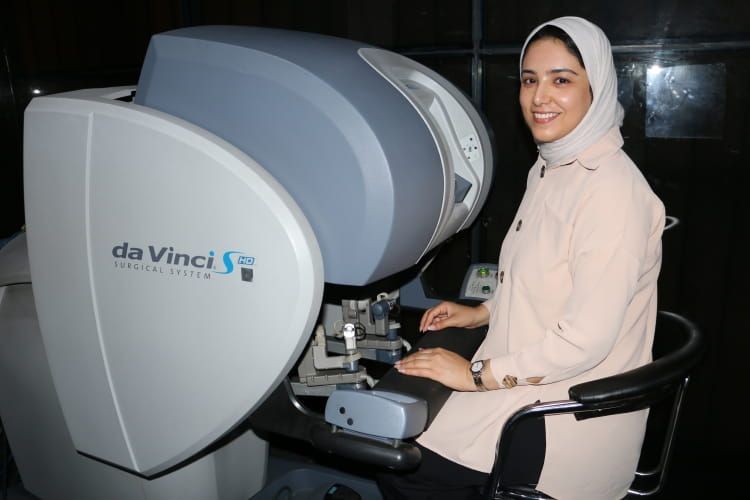Event Date: Mon - 17 Jul, 2023
Event Time: 12:10 pm
Location: World Laparoscopy Hospital
Institute: WLH
Patient Cart: The patient cart is the robotic arm system that is positioned close to the patient during surgery. It houses the robotic arms, which hold the surgical instruments and the endoscope (camera) that provides a 3D HD view of the surgical site. Vision Cart: The vision cart contains the high-definition monitor and the processing unit that generates the 3D images from the endoscope. Surgeons use the 3D view to navigate and perform precise movements during surgery. Master Console: The master console is where the surgeon sits during the procedure. It provides a highly intuitive interface that allows the surgeon to control the robotic arms and instruments with their own hand and finger movements. The system translates the surgeon's motions into precise movements of the robotic arms inside the patient's body. Instrument Designing: The instruments used in the da Vinci Surgical System are designed to mimic the dexterity and range of motion of the human hand. They have multiple joints and can rotate and bend, allowing for precise and complex maneuvers during surgery. Working Principles of da Vinci Surgical System: The da Vinci Surgical System works based on a concept called "telemanipulation." The surgeon operates the robotic arms from the master console, while the instruments at the patient cart mirror the surgeon's hand movements in real-time. This allows for greater precision and stability, reducing hand tremors and enabling more delicate surgeries. Optical 3D HD Technology: The da Vinci Surgical System utilizes an advanced optical system with 3D high-definition vision. The endoscope provides a stereoscopic view of the surgical site, enabling the surgeon to have depth perception and enhanced visualization during the procedure. Robotic Remote Sensor Technology and Docking: Additionally, the docking process involves securing the robotic arms and instruments to the patient cart before surgery, ensuring stability and precise alignment. Professor Dr. R. K. Mishra's explanation highlights the sophisticated technology and innovative design behind the da Vinci Surgical System, which has significantly advanced the field of minimally invasive robotic surgery and improved patient outcomes.World Laparoscopy Hospital: A Hub of Contemporary Learning with Daily 8-Hour Hands-On Laparoscopic Training
In the realm of medical education and training, there are institutions that stand out as pioneers, constantly pushing the boundaries of what is possible. One such institution is the World Laparoscopy Hospital, where a contemporary event unfolds every day, featuring a remarkable 8-hour hands-on laparoscopic training program.
A Daily Revolution in Learning
At the heart of the World Laparoscopy Hospital's mission is the commitment to train the next generation of surgeons and medical professionals in the art and science of Minimal Access Surgery. What makes this institution truly exceptional is its daily 8-hour hands-on laparoscopic training program.
The Laparoscopic Revolution
Laparoscopic surgery, often referred to as minimally invasive surgery, has revolutionized the field of surgery in recent decades. Instead of large incisions, this technique involves making tiny keyhole-like openings through which a camera and surgical instruments are inserted. This results in significantly reduced patient trauma, shorter recovery times, and less post-operative pain.
The Daily Experience at World Laparoscopy Hospital
Every day at World Laparoscopy Hospital is a contemporary event in the world of medical education. Here's a glimpse into what a typical day looks like for those fortunate enough to train at this prestigious institution:
1. Intensive Training: The 8-hour hands-on laparoscopic training is an immersive experience where trainees work side by side with experienced surgeons. This hands-on approach ensures that students gain practical skills and confidence in performing laparoscopic procedures.
2. State-of-the-Art Facilities: The hospital boasts state-of-the-art facilities, equipped with the latest laparoscopic instruments and technology. Trainees have access to the same tools and equipment used in modern surgical practices around the world.
3. Expert Faculty: The training is conducted under the guidance of expert faculty members who are pioneers in the field of Minimal Access Surgery. Their wealth of knowledge and experience provides students with invaluable insights and mentorship.
4. Customized Curriculum: The training program is tailored to the specific needs and experience levels of each student. Whether you are a novice or an experienced surgeon looking to refine your skills, there is a program to suit your requirements.
5. Global Reach: World Laparoscopy Hospital attracts medical professionals from all corners of the world. This diverse group of trainees fosters cross-cultural exchanges and collaborations, enriching the learning experience.
6. Research Opportunities: Beyond the hands-on training, the hospital also serves as a hub for research and innovation in the field of Minimal Access Surgery. Trainees have the opportunity to participate in cutting-edge research projects.
Impact Beyond the Classroom
The impact of the daily 8-hour hands-on laparoscopic training at World Laparoscopy Hospital extends far beyond the classroom. Graduates of this program return to their respective countries armed with advanced skills, contributing to the global dissemination of minimally invasive surgical techniques. Patients around the world benefit from the reduced invasiveness, faster recoveries, and improved outcomes that these skilled professionals bring to their practice.
In conclusion, World Laparoscopy Hospital's commitment to daily 8-hour hands-on laparoscopic training is a testament to its dedication to excellence in medical education. By offering a world-class learning environment and fostering a culture of innovation, this institution is shaping the future of surgery, one trainee at a time. It is not just an institution; it is a beacon of hope for patients and a driving force in advancing the field of surgery.


